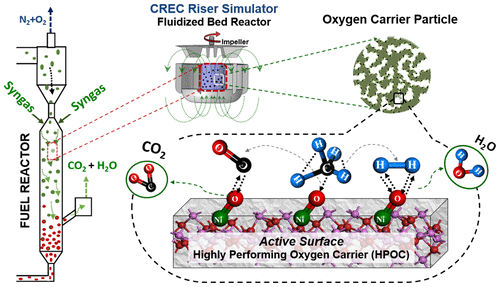当前位置:
X-MOL 学术
›
Ind. Eng. Chem. Res.
›
论文详情
Our official English website, www.x-mol.net, welcomes your
feedback! (Note: you will need to create a separate account there.)
Kinetic Model for Syngas Chemical Looping Combustion Using a Nickel-Based Highly Performing Fluidizable Oxygen Carrier
Industrial & Engineering Chemistry Research ( IF 3.8 ) Pub Date : 2019-02-11 , DOI: 10.1021/acs.iecr.8b05880 Imtiaz Ahmed 1 , Hugo de Lasa 1
Industrial & Engineering Chemistry Research ( IF 3.8 ) Pub Date : 2019-02-11 , DOI: 10.1021/acs.iecr.8b05880 Imtiaz Ahmed 1 , Hugo de Lasa 1
Affiliation

|
The study reports a kinetic model for a nickel-based highly performing oxygen carrier (HPOC). This HPOC is free of nickel aluminates and can perform very efficiently at lower temperatures (i.e., 550–650 °C). In this study, a kinetic model is proposed to predict syngas chemical looping combustion (CLC) using an HPOC. The syngas used in this study emulates the syngas that can be derived from biomass gasification containing H2, CO, CH4, and CO2. To establish the kinetic model, isothermal runs are developed in the CREC riser simulator, which is a mini-batch fluidized bed reactor. The operating conditions are varied between 2 and 40 s reaction times and 550–650 °C, with the H2/CO ratio being 2.5 and 1.33 and with the ψ parameter (fuel stoichiometric oxygen to HPOC oxygen ratio) being 0.5 and 1. For the 2.5 and 1.33 H2/CO ratios, a 92% CO2 yield with 90% CO, 95% H2, and 91% CH4 conversions are achieved. In addition, the HPOC shows an oxygen transport capacity ranging between 1.84 and 3.0 wt % (gO2/gOC) with a 40–70% oxygen carrier oxygen conversion. The solid-state kinetics considered uses of a nucleation and nuclei growth model. The proposed kinetics leads to a model with 10 independent intrinsic kinetic parameters. The various kinetic parameters are determined via numerical regression within a 95% confidence interval and small cross correlation coefficients. According to the frequency factors obtained, the reactivity of the species with a HPOC can be expressed following the H2 > CO > CH4 order. Given that the HPOC shows high performance and stability, it is anticipated that the developed kinetic model could contribute to establishing large-scale reactor CLC for syngas combustion.
中文翻译:

镍基高性能流态化氧气载体的合成气化学循环燃烧动力学模型
该研究报告了镍基高性能氧气载体(HPOC)的动力学模型。该HPOC不含铝酸镍,可在较低温度(即550–650°C)下非常有效地发挥作用。在这项研究中,提出了一种动力学模型来预测使用HPOC的合成气化学循环燃烧(CLC)。本研究中使用的合成气模拟了可从含有H 2,CO,CH 4和CO 2的生物质气化中得到的合成气。为了建立动力学模型,在CREC立管模拟器中开发了等温运行,该模拟器是一个小批量流化床反应器。使用H 2时,操作条件在2到40 s反应时间和550–650°C之间变化。/ CO比为2.5和1.33,并且ψ参数(燃料化学计量氧与HPOC的氧比)为0.5和1。对于2.5和1.33 H 2 / CO比,92%的CO 2收率,其中90%的CO,95% H 2和91%CH 4的转化率得以实现。此外,HPOC的氧气传输能力介于1.84和3.0 wt%(gO 2/ gOC)和40-70%的氧气载体氧气转化率。固态动力学考虑了使用成核和核生长模型。拟议的动力学导致具有10个独立的内在动力学参数的模型。各种动力学参数是通过在95%置信区间内和较小的互相关系数内的数值回归确定的。根据获得的频率因子,该物种与HPOC的反应性可以按照H 2 > CO> CH 4的顺序表示。鉴于HPOC显示出高性能和稳定性,因此可以预期,所开发的动力学模型将有助于建立用于合成气燃烧的大规模反应器CLC。
更新日期:2019-02-11
中文翻译:

镍基高性能流态化氧气载体的合成气化学循环燃烧动力学模型
该研究报告了镍基高性能氧气载体(HPOC)的动力学模型。该HPOC不含铝酸镍,可在较低温度(即550–650°C)下非常有效地发挥作用。在这项研究中,提出了一种动力学模型来预测使用HPOC的合成气化学循环燃烧(CLC)。本研究中使用的合成气模拟了可从含有H 2,CO,CH 4和CO 2的生物质气化中得到的合成气。为了建立动力学模型,在CREC立管模拟器中开发了等温运行,该模拟器是一个小批量流化床反应器。使用H 2时,操作条件在2到40 s反应时间和550–650°C之间变化。/ CO比为2.5和1.33,并且ψ参数(燃料化学计量氧与HPOC的氧比)为0.5和1。对于2.5和1.33 H 2 / CO比,92%的CO 2收率,其中90%的CO,95% H 2和91%CH 4的转化率得以实现。此外,HPOC的氧气传输能力介于1.84和3.0 wt%(gO 2/ gOC)和40-70%的氧气载体氧气转化率。固态动力学考虑了使用成核和核生长模型。拟议的动力学导致具有10个独立的内在动力学参数的模型。各种动力学参数是通过在95%置信区间内和较小的互相关系数内的数值回归确定的。根据获得的频率因子,该物种与HPOC的反应性可以按照H 2 > CO> CH 4的顺序表示。鉴于HPOC显示出高性能和稳定性,因此可以预期,所开发的动力学模型将有助于建立用于合成气燃烧的大规模反应器CLC。











































 京公网安备 11010802027423号
京公网安备 11010802027423号